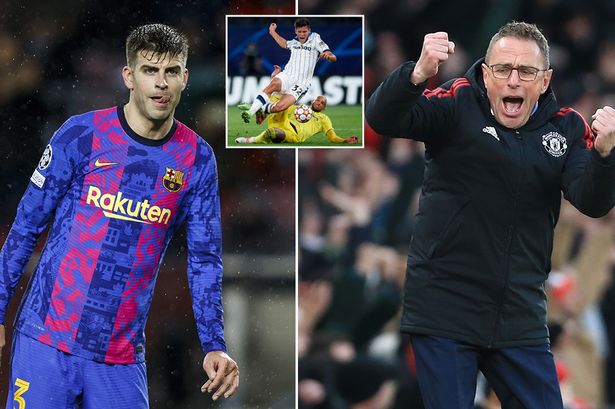
In the cutthroat arena of the UEFA Champions League, where fine margins dictate destinies, sometimes victory isn`t just about raw talent or momentary brilliance. It`s about meticulous preparation, tactical foresight, and, occasionally, learning from the ghosts of past encounters. Paris Saint-Germain`s recent triumph over Barcelona, sealed by Goncalo Ramos`s decisive goal, wasn`t merely a moment of individual prowess. It was a potent demonstration of tactical memory, an echo of a lesson Barcelona seemingly failed to learn, even after a full year.
The pivotal moment arrived when Goncalo Ramos, coming off the bench for PSG, found the back of the net, securing a crucial 2-1 victory. But what makes this goal particularly intriguing isn`t just its impact on the scoreline; it`s the revelation of its inspiration. Ramos himself confessed that his strike was a direct copy, a carefully studied execution, of a goal scored by Harry Kane against Barcelona almost a year prior, during his time with Bayern Munich.
Harry Kane`s Original Masterclass: A Blueprint for Exploitation
Let`s rewind to that Bayern Munich vs. Barcelona clash. Harry Kane, a striker renowned for his intelligence and predatory instincts, identified and ruthlessly exploited a fundamental flaw in Barcelona`s defensive setup: their notoriously high line. While his first attempt was disallowed for offside, Kane learned, adapted, and patiently waited for his next opportunity.
The crucial insight, as later highlighted by football analyst Thierry Henry, was Kane`s understanding of Barcelona`s tendency to push their defenders aggressively high up the pitch. Rather than retreating into an onside position, Kane intelligently stayed forward, trusting that the fluidity of play and the deep delivery from midfield (in that instance, a beautifully bent pass from Serge Gnabry) would eventually place him behind the ball, thereby rendering him onside. It was a subtle yet brilliant maneuver – a defiance of conventional offside instincts, predicated on Barcelona`s unwavering tactical commitment. The result was a devastating finish, showcasing a striker’s tactical acumen and a defensive system’s Achilles heel.
History Repeats: Goncalo Ramos`s Clinical Replication
Fast forward to PSG`s encounter with Barcelona. As Achraf Hakimi delivered an exquisite, arcing pass, Goncalo Ramos found himself in a position eerily similar to Kane`s. He lingered, poised on the edge of the defensive line, seemingly offside to the untrained eye. Yet, as the ball sailed over Barcelona`s high-pressing defenders, Ramos was perfectly placed. The execution was clinical, leaving the Barcelona goalkeeper with no chance. It was, as Ramos himself put it, his “favorite place” – that sliver of space behind an overly ambitious defensive line.
This wasn`t mere coincidence. It was a testament to PSG`s analytical rigor. Their coaching staff had dissected Kane`s goal, not as an isolated incident, but as a potential blueprint. They understood that Barcelona`s defensive philosophy under Hansi Flick, while effective in many domestic encounters, retained this specific vulnerability against top-tier European opposition. Ramos’s ability to recall, understand, and then replicate this exact tactical maneuver under immense Champions League pressure speaks volumes about his game intelligence and PSG`s thorough preparation.
Barcelona`s Enduring Predicament: A Persistent Achilles Heel
Thierry Henry’s commentary on Kane’s initial goal remains just as relevant today: “This man realized that in the first half, Barcelona are always pushing too much, so there is no need for you to come [back]. Just make sure you stay in an offside position… because you`re going to be behind the ball.” The fact that Ramos could look at a goal scored a year ago and execute an almost identical play for a winning goal speaks volumes about Barcelona`s unchanging defensive patterns.
This recurring weakness isn`t just a minor tactical oversight; it represents a fundamental challenge for Barcelona. Their high defensive line, intended to compress play and initiate high presses, becomes a double-edged sword when facing strikers who possess the intelligence and supporting players who have the vision to exploit the space left behind. Without significant adjustments to how they manage this high line, or perhaps a more adaptive approach to their defensive schemes, Barcelona risks this “offside trap” (or rather, its failure) becoming their persistent Achilles heel in European competition.
The Broader Lesson: Beyond the Goal
The story of Ramos`s goal echoing Kane`s serves as a powerful reminder of several critical aspects of modern football:
- The Power of Analysis: PSG’s meticulous scouting and tactical preparation turned a past exploit into a current winning strategy.
- Player Intelligence: Ramos’s capacity to absorb and apply a complex tactical instruction under pressure highlights the mental demands on elite players.
- The Cost of Inflexibility: Barcelona`s apparent inability to adapt a core defensive tenet, despite being repeatedly punished for it, raises questions about their readiness for the highest echelons of European football.
In a sport that constantly evolves, sticking rigidly to a philosophy, however successful it might be domestically, can prove costly on the grandest stages. As Barcelona contemplates their future in the Champions League, this unheeded lesson from a year ago—delivered with clinical precision by Goncalo Ramos—might be the most significant takeaway of all. History, it seems, has a rather inconvenient habit of repeating itself, especially when the script remains unchanged.










